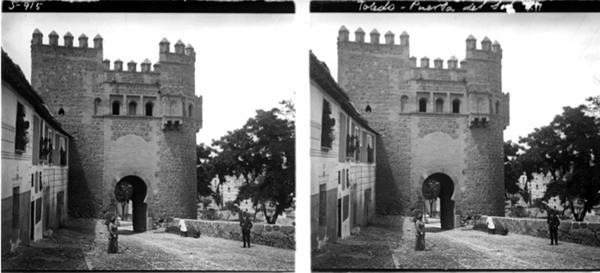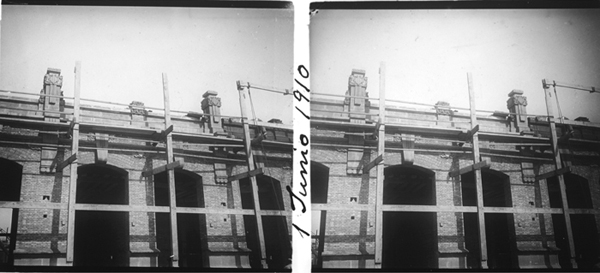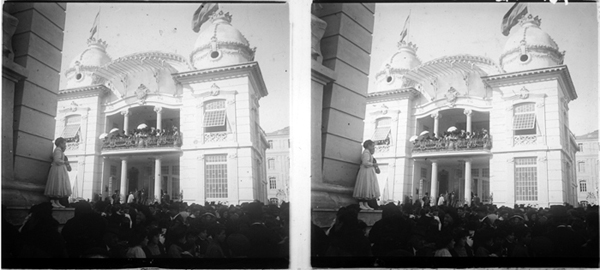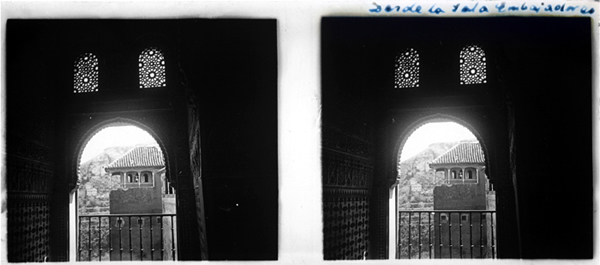The gaze of the architect
|
The gaze of the architect
Demetrio Ribes and his
stereoscopic camera
From 15 May to 2 September 2007
Thesaurus room - La Nau
From
Tuesday to Saturday, from 10 to 13.30 and from 16 to 20 h.
Sunday, from 10 to 14 h.
|
|
|
|

Toledo, Puerta del Sol. May, 1915 |
|
|
|
Demetrio Ribes Marco (Valencia, 1875-1921) was one of
the most relevant Valencian architects of the early 20th
century. Trained in eclectic tradition and a versatile
and diverse architectural environment, his works are
framed within the secessionist branch of Modernism
(Valencia’s North Station, offices of the Príncipe Pío
Station in Madrid, Vilanova Station in Barcelona) and
the preludes of Rationalism (Ernesto Ferrer stores,
Játiva bullring, villa on Malvarrosa beach).
His early works display a new art, free from traditional
perceptions, where the concept of total art is
dignified. Gentleness, painstaking design, and the use
of applied arts are their main traits. A process in
which the advantages and features of reinforced concrete
were boosted, at the same time offering a language
consistent with this material: absence of ornamentation,
severe composition, clear plans, articulation of space,
functional distribution, etc. He was the first architect
to introduce reinforced concrete in civil building in
Valencia.
But his professional activity was not limited to
creating and building works. Ribes was an architect
committed to the problems of his time, particularly in
architectural discussions and in his job. His
theoretical works tells us about an architect open to
new currents in architecture, new building systems, new
languages, regardless of their origin… a man who stood
up for a modern architecture based on functional and
structural needs. He is a singular, undeniable figure in
the history of Spanish architecture. His theoretical and
practical works shall remain with us in the annals. |
|
|
|

Valencia, aviation competition, Malvarrosa Beach. June,
1910 |
|
|
|
The exhibition
Curated by Inmaculada Aguilar Civera, the exhibition
presents a new side to the architect, namely amateur
photography, a medium where his gaze reveals the objects
that motivated him. His dual profile as an architect and
a builder, his deep relationship with engineering, his
open mind to new architectural languages and new
constructive systems, his dynamism and entrepreneurship,
and his respect of past architecture are the guidelines
for the understanding of his buildings and photographs.
The exhibits belong to the Guillot-Ribes collection and
have been borrowed from Demetrio Ribes’ family. They are
digital reproductions of stereoscopic glass plates
(6x13cm) produced by a Vérascope camera manufactured by
Richard. The photographs of this unpublished
collection have been exhibited only on a few occasions.
They are photographs taken by Ribes between 1908-1918,
when he travelled most of Spain with his camera:
Barcelona, Lérida, San Sebastián, Zaragoza, Pamplona,
Segovia, Madrid, Toledo, Córdoba, Granada, Sevilla,
Valencia, and some smaller towns. His point of view is
very similar to that of 19th century
photographers, his iconography is usually the monument
-a commonly deserted architecture-, the presence of
actors being accessory and isolated. His view of
constructive works is different: he focuses on workmen
and their trades, and on constructive details. As to
topicalities, he is interested in cities, their
festivities, fairs, habits, large events... |
|
|
|

Valencia, North Station under construction. June, 1910 |
|
|
|
The exhibition is structured into four blocks:
The encounter with history
A dialogue with the present
Railway architecture and the familiarity of the works
Topicalities: fairs, celebrations and exhibitions |
|
|
|

Valencia, Regional Exhibition, Gran Casino. 1909 |
|
|
|
The exhibition is interesting for two reasons. On the
one hand, it is a stereoscopic photography exhibition.
Stereoscopic photography allowed us to view the third
dimension. It was a turning point for photography, as
there was a shift from the view to the landscape as a
descriptive category. Viewing stereoscopic images became
one of the fashionable hobbies of the time. Stereoscopic
cards became really popular until the 1930s, thousands
of copies and different viewing devices being sold.
On the other, the photographic instant is a historic
moment, a document and a file of what happened those
years, hence the value added of the exhibition, which
chronologically reports on the condition of national
monuments, the evolution of contemporary architecture,
the constructive development of railroad works, the
detail of trades, and Spanish and Valencian activity in
fairs and celebrations. |
|
|
|

La Alhambra (from Sala Embajadores). 1917 |
|
|
|
|